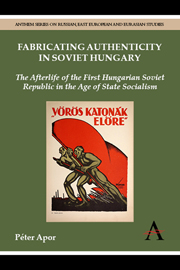 Fabricating Authenticity in Soviet Hungary
Fabricating Authenticity in Soviet Hungary Published online by Cambridge University Press: 05 April 2014
On 21 March 1949, the Hungarian Federation of Freedom Fighters – a Communist partisan organization which allegedly consisted of wartime anti-Nazi resistance fighters, but which was mostly a fiction to convince Hungarians of the existence of an indigenous Communist resistance movement – organized a bicycle and motorbike race around blocks of flats in Budapest. The competition was part of a set of ceremonies commemorating the proclamation of the First Hungarian Soviet Republic on 21 March 1919. The director of the Institute for Party History, László Réti, justified its appropriateness as follows: ‘We have to take care of, and improve the spirit of, fighting for freedom, a spirit the representatives of which construct with one hand, while with the other hand – if they must – they defend, even with weapons, their own constructions. The best illustrations for fostering this spirit of freedom fight are provided by the heroes who were fighting for the Soviet Republic.’ Of all the commemorative events of the 30th anniversary, this bicycle race was probably the most curious.
Postwar Hungarian Communists wanted to construct the history of 1919 as an instance of a ‘usable past’ and establish the First Hungarian Soviet Republic as the praefiguratio of their own regime. In this way they could benefit from previous Soviet exercises in historical typology, which identified episodes in the past as models for contemporary political action.
To save this book to your Kindle, first ensure [email protected] is added to your Approved Personal Document E-mail List under your Personal Document Settings on the Manage Your Content and Devices page of your Amazon account. Then enter the ‘name’ part of your Kindle email address below. Find out more about saving to your Kindle.
Note you can select to save to either the @free.kindle.com or @kindle.com variations. ‘@free.kindle.com’ emails are free but can only be saved to your device when it is connected to wi-fi. ‘@kindle.com’ emails can be delivered even when you are not connected to wi-fi, but note that service fees apply.
Find out more about the Kindle Personal Document Service.
To save content items to your account, please confirm that you agree to abide by our usage policies. If this is the first time you use this feature, you will be asked to authorise Cambridge Core to connect with your account. Find out more about saving content to Dropbox.
To save content items to your account, please confirm that you agree to abide by our usage policies. If this is the first time you use this feature, you will be asked to authorise Cambridge Core to connect with your account. Find out more about saving content to Google Drive.